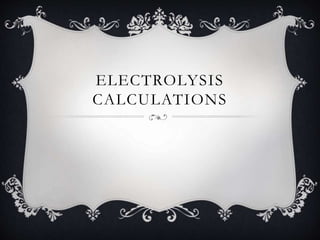
Electrolysis calculations
- 2. A LOOK AT HALF-EQUATIONS A half equation really just tells you the number of electrons removed or added to an ion: The following half-equation tells us that 1 mole of electrons is lost from sodium metal to form1 mole of sodium ions: Na – 1e- → Na+
- 3. THIS MEANS THAT Mg – 2e- → Mg2+ Al – 3e- → Al3+ Cl + 1e- →Cl- 1 mole of Magnesium needs to lose 2 moles of electrons to form 1 mole of magnesium ion 1 mole of aluminium needs to lose 3 moles of electrons to form 1 mole of aluminium ion 1 mole of chlorine atoms need to gain 1 mole of electrons to form 1 mole of chloride ion
- 4. Let’s assume that for sodium metal, only half the number of moles of electrons are supplied. BUT SUPPOSE YOU DON’T HAVE THE SUFFICIENT AMOUNT OF MOLES? Since the ratio between moles of electrons to moles of sodium metal is 1:1, then 0.5 moles of electrons should supply 0.5 moles of Na+ ions In essence, the number of moles of electrons is directly proportional to the number of ions in electrolysis and vice-versa
- 5. HOW DO YOU KNOW THE AMOUNT OF ELECTRONS IN THE CELL? It has been determined that 1 mole of electrons has a charge of 96,500 Coloumbs (C). This number of Coulombic charge is equal to 1 Faraday (F) Charge of 1 mole of electrons = 96,500 C = 1F
- 6. WHAT IS CURRENT? The word, current, refers to the rate of flow of electricity One ampere (amp) is equal to a rate of flow of charge of 1 Coulomb every second Therefore, amps = Coulombs/second and Coulombs = amps * seconds
- 7. WHAT IS CURRENT? This can be denoted by the following equation: Q = I x T Where Q = quantity of charge in coloumbs I = current in Amps T = time in seconds
- 8. RELATIONSHIPS BETWEEN Number of moles of electrons Amount of electric current Time current passed through the system Mass of product at electrodes
- 10. EXAMPLE 1 Calculate the mass of copper produced in 1.5 hours by the electrolysis of molten CuCl2 if the electrical current is 12.3 Amps
- 11. STEP 1: DETERMINE CHARGE Since the charge in Couloumbs = amps * seconds or Q = I x TQ = 12.3 amps * 1.5 hours * 60 min/hour * 60 sec/min Q = 6.64 x 104 C
- 12. STEP 2:DETERMINE NUMBER OF ELECTRONS Therefore, 6.64 x 104 Coulombs total pass into the reduction cell (cathode) during the reaction. Since 96,500 C is the charge for 1 mole of e-, 96,500 C = 1 mole of e- 1 C = (1/ 96,500) mole of e- 6.64 x 104 C = 6.64 x 104 C * (1 mole e- / 96,500C) = 0.688 moles e-
- 13. STEP 3:DETERMINE NUMBER OF MOLES OF ION/METAL PRODUCED How many moles of Cu can be reduced with 0.688 moles of electrons? The half-equation for this reaction is Cu2+ + 2e- → Cu This means that it takes 2 moles of e- to produce 1 mole of Cu or 1 mole of e- to produce 1/2 mole of Cu Therefore 0.688 moles e- = 0.688 * (1/2) = 0.344 moles Cu
- 14. STEP 4:DETERMINE MASS OF ION/METAL PRODUCED Finally, how many grams of Copper are there per mole? The relative atomic mass of copper, Ar = 63.5 g/mole This means that 1 mole of Cu has a mass of 63.5 g Therefore 0.344 moles of Cu = 0.344 * 63.5 = 21.8 g
- 15. EXAMPLE 2 In the industrial production of chlorine gas, a current of 50,000 A was passed through a salt solution for 1 hour. Calculate the volume of gas which would be produced. Take the molar volume to be 24 dm3 / mol.
- 16. STEP 1: DETERMINE CHARGE Since the charge in Couloumbs = amps * seconds or Q = I x T I = 50000 A t = 3600 s Q = I × t = 50000 × 3600 = 180000000 = 1.8 × 108 C
- 17. STEP 2:DETERMINE NUMBER OF ELECTRONS Therefore, 1.8 × 108 Coulombs total pass into the cell (anode) during the reaction. Since 96,500 C is the charge for 1 mole of e-, 96,500 C = 1 mole of e- 1 C = (1/ 96,500) mole of e- 1.8 × 108 C = 1.8 × 108 C * (1 mole e- / 96,500C) = 1,865.28 moles e-
- 18. STEP 3:DETERMINE NUMBER OF MOLES OF ION/METAL PRODUCED How many moles of Cl2 can be produced from 1,865.28 moles of electrons? The half-equation for this reaction is 2Cl-(aq)→Cl2(g) + 2e- This means that it takes 2 moles of e- for every 1 mole of Cl2(g) or 1 mole of e- for every 1/2 mole of Cl2(g) Therefore 1,865.28 moles e- = 1,865.28 * (1/2) = 932.64 moles Cl2(g)
- 19. STEP 4:DETERMINE MASS/ VOLUME OF ION/METAL/ GAS PRODUCED Now, assuming room temperature and pressure (RTP), (20◦C and 1 atmosphere presssure) Molar volume of chlorine gas , Cl2(g)= 24 dm3 This means that 1 mole of Cl2(g) occupies a volume of 24 dm3 Therefore 932.64 moles Cl2(g) = 932.64 x 24 = 22, 383.36 dm3
